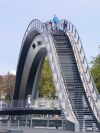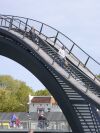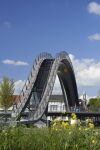The Melkweg Bridge is part of the master plan Kanaalsprong in Purmerend, which aims to connect the old and new city. The design responds to the transforming environment of Purmerend; the location of the canal has changed from the edge of the city into a centrally located area. The iconic bridge reinforces the identity of the area and forms a characteristic link that brings the Weidevenne district and the historic city closer together.
Within this process, the bridge does not only contribute as an infrastructural element but also as a supplement to the public space: the new iconic destination reinforces the positive experience of the environment. The structure is more than just a physical connection across the canal, it is a pleasant place to stay that offers a unique perspective on the city.












